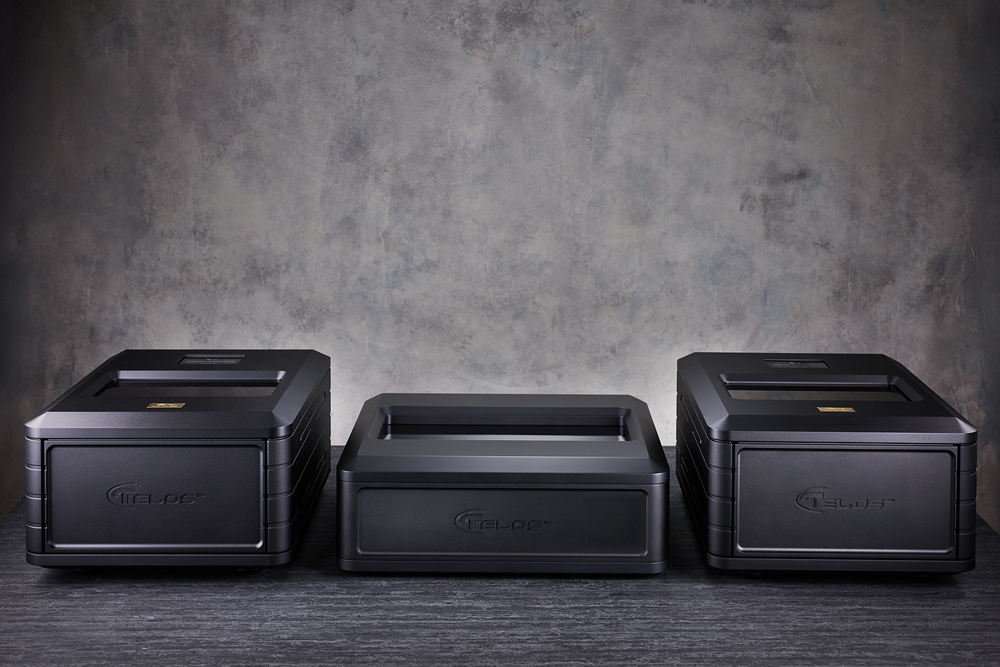When I cut my teeth as a sound engineer, it wasn’t in some pristine temple of acoustic perfection. It was in studios that reeked of stale smoke, the walls painted with decades of sweat, tears, and spilled Budweiser, and for two years I had the privilege of having custodianship of SAE Glasgow during the holidays. I’d stay back long after the sessions ended, the last of the band long gone, and I’d cue up Sheryl Crow’s Tuesday Night Music Club. “I Shall Believe” would drift through the room, carried by a pair of Tannoy System 15 monitors, filling the room with a weight that didn’t come from decibels but from soul.
Resurrection Through Silence
In those days, the lights on the console would dance in rhythm, little beacons of life in the semi-darkness. Cigarettes smouldered in the ashtray, and the bottles lined up like veterans standing at parade rest, the silent trophies of another night survived. Donald Fagen, Alanis Morissette, Sheryl, they weren’t just playing, they were conjuring, and I sat there like a willing acolyte, breathing in the room as it breathed music back into me. Two lovers locked in rhythm: the sound and my all too regularly broken 21 year old heart.
In those nights, clarity wasn’t just about frequency response charts or distortion figures. It was about the feeling of breath in the mix, the way a vocal floated above the ash and haze, the shimmer of a cymbal decaying into eternity. Music was more than an arrangement of notes – it was atmosphere, it was confession, it was life unfiltered.
And then there was power. The monster under the console, the heartbeat of the system, the thing most people forgot about. The Telos Audio Design gear hadn’t entered my life yet, but I already knew, instinctively, viscerally, that electricity wasn’t neutral. The mains hum, the hiss between tracks, the static that haunted the silences: these weren’t accidents. They were intrusions, ghosts in the circuitry, the invisible thieves of truth.
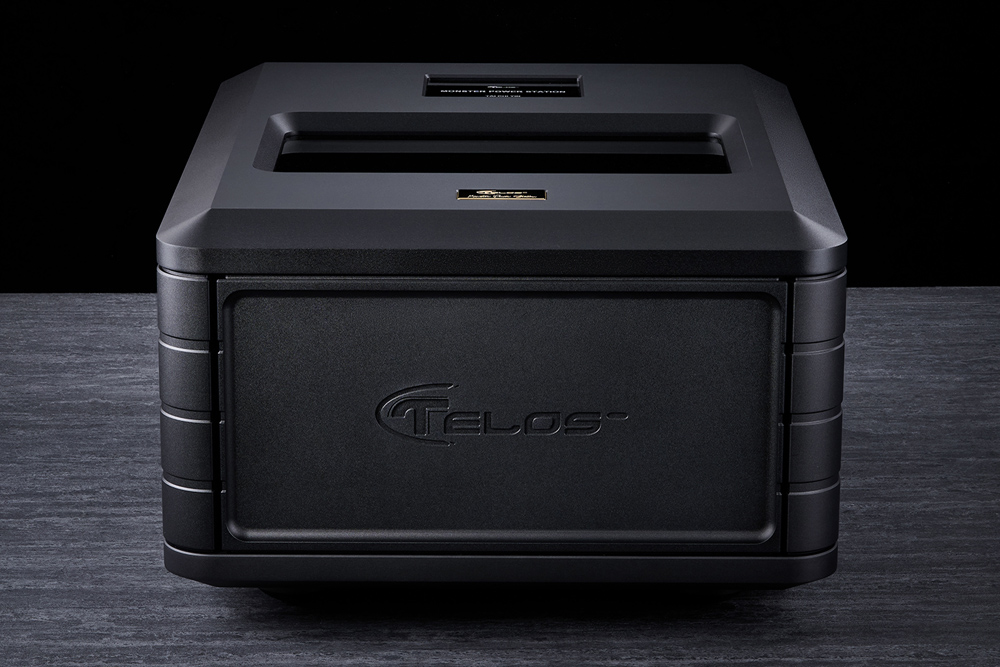
Years later, standing in my own listening room, those memories would come back with brutal clarity. Because when you strip music down to its essence, to the breath of a voice, the scrape of a string, the thunder of a kick drum, what you’re really chasing is the absence of interference. The silence that makes sound possible.
Most people think hi-fi is about the speakers, the amps, the sexy front-end gear. And sure, that’s where the romance lies. But ask anyone who’s ever mixed a record, anyone who’s built a studio from the floor up, and they’ll tell you: power and grounding are the foundation. Get them wrong, and everything else is lipstick on a corpse.
Power and ground are invisible. You don’t see them. You don’t Instagram them. They don’t glow with tubes or sparkle with chrome. They just sit there, quietly holding the line. But when they’re right? Everything changes. The air clears. The haze lifts. And suddenly you’re back in that room at 2 am, when music felt like truth itself.
Jeff Lin
Jeff Lin and I didn’t meet like strangers. When he arrived at my house, it wasn’t a handshake, it was a hug. We’d already met in Singapore, and I knew the kind of man he was: humble, sharp, quietly brilliant. The equipment had arrived the week before, waiting like unopened presents, and now Jeff was here to bring them to life.
He didn’t show up with theatrics or grand claims. He walked in with quiet confidence, carrying two deceptively simple-looking boxes: the Telos Audio Design Monster Series Power Station and the Telos Earth Grounding, both in ‘Standard Edition’ versions. To be honest, I was still sceptical. I’ve seen too many so-called “revolutionary” power solutions that promised blacker backgrounds, holographic soundstages, sweeter highs, only to deliver a subtle tweak at best, or worse, nothing at all. My plan, if I’m brutally honest, was to smile politely, thank him for his time. Pretence has never been my thing. If it was bullshit, I’d call it.
Jeff started simple. He connected the Ground unit to power but didn’t attach any of my components yet. He pulled out a meter, not a gimmick, not a magic wand, but a proper measurement device, and began taking readings from my power boards. Immediately, there were measurable differences. Noise levels dropping, clear numerical shifts on the display. But to my ears? Nothing dramatic. Not yet. I sat there thinking, “this is where the spin usually starts…”. This is the moment when someone leans in and says, “Listen harder. Can’t you feel it?” Yet, Jeff didn’t do that. No fairy dust, no vague language about “energy fields” or “quantum vibrations.” Just data. He let the numbers do the talking.
Then he moved on to the real work. This time, he used a device connected to his phone to measure the grounding potential of each of my components, the amp, the preamp, the DAC, the streamer. Each showed different levels of noise, each with its own quirks and grounding issues. Jeff explained what he was seeing in plain, precise language. And then, one by one, he began connecting them to the Earth Grounding component. That’s when the room shifted.
He sat down next to me as the system came alive. He translated what was happening in real time on our phones, smiling as the “orchestra” assembled before us, nothing missing, no weak links, every instrument finally finding its rightful place. At one point he threw me a fist pump, and I couldn’t help but laugh. My system had always drawn compliments for its performance, and I thought it was already operating near its peak. I wasn’t expecting much more… but what hit me was staggering.
The clarity wasn’t a subtle polish, it was a revelation. The soundstage didn’t just expand; it finally found its relationship with the architecture, allowing the walls to breathe. Voices that always seemed to hang in the air, suddenly found a new confidence, the kind of presence only spiritual rapture could provide. They stepped forward, flesh and bone, breathing in the room. Instruments that had always been present suddenly had newfound presence, some kind of ghostly aura in the mix. The air around each instrument cleansed, like a pure highland morning.
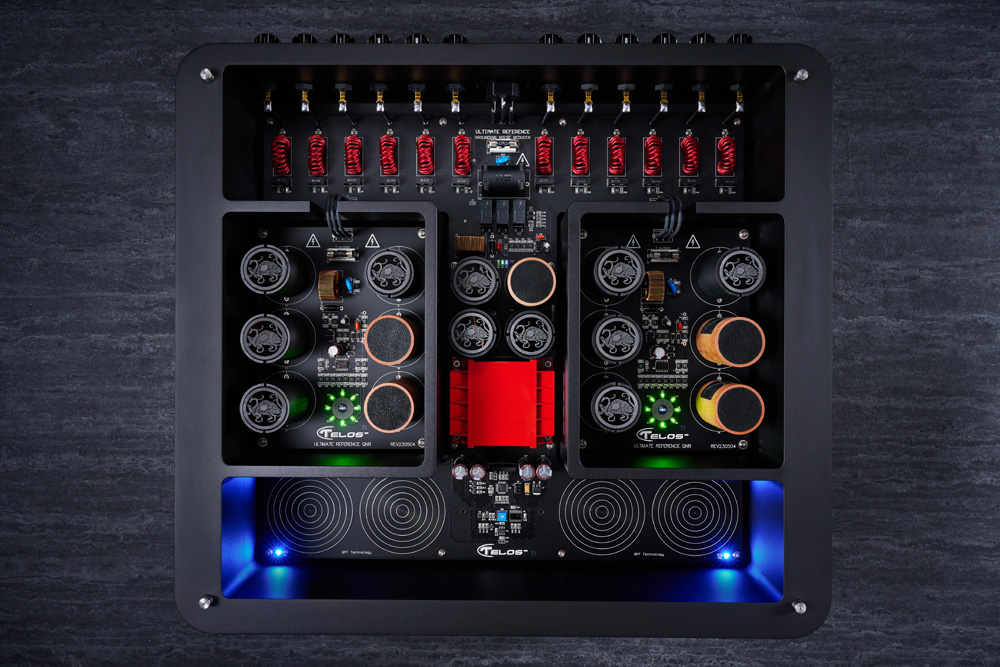
And then there was the silence. Or rather, the living silence. The spaces between notes transformed. They weren’t empty gaps anymore; they became canvases, giving shape and meaning to every transient. This idea of zero background noise wasn’t theoretical. It was physical. A presence you could feel as much as hear.
I’ve used power solutions before. The Nordost QKore, for example, impressed me as a surprisingly effective step up from a high-quality power board. Respectable. Worthwhile. But what Telos was doing here wasn’t a step. It wasn’t even in the same sport. This wasn’t refinement. This was a dimension shift.
The sceptic in me tried to resist. The studio engineer in me wanted to write it off as confirmation bias. But the music pouring out of my system refused to be denied. This wasn’t placebo. This wasn’t subtle. This was a slap across the face, a shock of cold water, a demand to sit up and pay attention.
And that’s when it hit me: this wasn’t hi-fi jewellery. This wasn’t fetishism for the sake of status. This was fundamental. This was bedrock. The amps, the cables, the speakers, they’re the instruments. But without clean, stable, intelligently grounded power, you’re asking an orchestra to perform on a cracked, sagging stage. One you’re never aware of it until you become aware of it.
These are key specifications and features of the Monster Series Power Station Standard Edition and Earth Grounding Standard Edition as stated by Telos (for short):
Telos Power Station – Specifications & Design
Specifications
- Output Channels: 8 × AC outputs
- Output Voltage: 100–240 V / 50–60 Hz (dependent on input power)
- Input Power Voltage: 100–240 V / 50–60 Hz
- Maximum Current Capacity: 32 A
- Full Load Output Power: 1,800 watts
- Standby Power Consumption: 6 watts
- Nude Packed Weight: 48 kg
- Packaged Weight: 68 kg
Innovation
- Multi-module composite material framework for superior structural and electrical integrity.
- Exclusive patented electrical noise elimination technology.
- 11 synchronized resonance chips for precise component matching and performance optimization.
- Premium capacitor array featuring German Mundorf and Danish Duelund top-tier components.
- Internal sound-tuning modules incorporating 3D-printed damping mechanisms.
- Oyaide SSC Superconductor wiring (102% conductivity rating) for ultra-low resistance and phase coherence.
Design
- Matrix-style sound field simulation architecture developed by Jeff Lin.
- Composite modular casing engineered to completely separate structural stress from electronic modules, ensuring optimal resonance control.
- Precision CNC housing and advanced material selection establish the Power Station as a premier Telos reference-class power conditioner.
Telos Earth Grounding Unit – Specifications & Design
Overview
In traditional electronics, grounding is a safety requirement: a means to divert leakage current and induced charges to earth, preventing equipment casings from becoming live and ensuring user safety.
In audio, grounding goes further. By eliminating noise at its root, it purifies the signal path, reduces distortion, and elevates system performance. The result is sound that is cleaner, more natural, and profoundly engaging.
The Telos Grounding Unit redefines this principle for high-end audio systems, delivering both safety and sonic refinement.
Specification
- Grounding Connectors: 12 × WBT NextGen™ WBT-0703 Cu pole terminals
- Power Input: 100–120 V or 200–240 V (dependent on region)
- Nude Packed Dimensions: 48.5 × 46 × 17 cm
- Nude Packed Weight: 45 kg
- Packaged Dimensions: 63 × 55 × 39 cm
- Packaged Weight: 65 kg
Innovation
- Incorporates QMT Quantum Magnetism Technology, Telos V5.1 Schumann Wave generators, and QNR Quantum Noise Reduction modules.
- Delivers measurable improvements even in ungrounded configurations.
- Purpose-built for large-scale, reference-grade systems requiring greater grounding capacity and multiple connection points.
- Active operation ensures significant noise elimination, producing enhanced clarity, staging, and tonal realism.
Accessories Included: One DC Power Cable (1.92 m) and 12 Grounding Wires with Y-plug connectors (1.92 m each)
The thing about grounding and power is that most people don’t see it, literally or figuratively. You don’t walk into a listening room and marvel at the power conditioner the way you might over a pair of sculptural loudspeakers or a gleaming turntable. Power is invisible. Until it isn’t.
Telos has made it its mission to turn that invisibility into the foundation of everything else. And it doesn’t do it with vague promises or mystical language. Telos does it with engineering. Meticulous and obsessive engineering.
Single-Point Grounding
The Earth Grounding is built on the principle of single-point grounding. In simple terms: every component in your system gets tied to one reference point, like musicians in an orchestra all tuning to the same pitch. Without it, each device floats on its own slightly different electrical island, introducing micro-voltages that leak into the signal chain. It’s like each section of a band drifting a few cents sharp or flat — you don’t notice the error immediately, but you feel the dissonance.
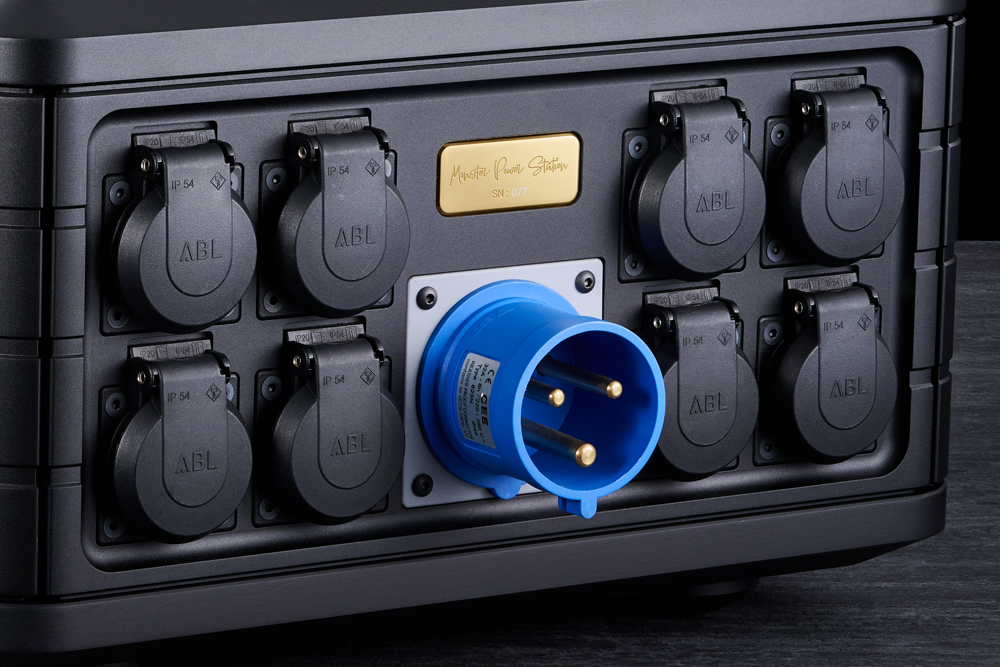
By unifying the system to one ground reference, Telos eliminates that discord. The effect isn’t subtle. The result is coherence: instruments lock in, timing sharpens, and the music gains an undeniable sense of “togetherness.”
Latency: <1 Nanosecond
The Earth Grounding is claimed to operate with a latency of less than one nanosecond. That’s a billionth of a second, faster than the time it takes for light to travel a foot. In practice? It means that when your gear throws noise into the ground, the Telos responds instantly. Think of it like a drummer who’s always exactly on the beat, not rushing, not dragging. Just perfect timing.
The Ground Reference Oscillator (GRO)
Traditional grounding systems average the noise across devices and hope for the best. Telos doesn’t hope. Earth Grounding generates its own Ground Reference Oscillator (GRO), a synchronised clock tied to your power frequency. It acts like a conductor with perfect time, absorbing interference and synchronising the entire system. Instead of a band counting silently, you’ve got a baton waving with absolute authority. As Jeff Lin states, “This reference potential is compared with feedback signals generated from each terminal load, and the system provides inverse absorption channels through current differential methods, allowing floating noise from various equipment to "discharge" toward this reference potential. Its stability is far superior to traditional chassis grounding or ground stake methods.”
Three-Layer EMI Shielding
Noise isn’t just internal, it comes from everywhere: Wi-Fi routers, dimmer switches, your neighbour’s gear. Telos built the Earth Grounding like punk armour with three layers of EMI defence. A CNC-machined aluminium chassis acting as a Faraday cage, balanced internal circuits with ferrite beads, filters, and carbon modules that swallow RF nasties above 1 MHz, and terminal-level traps tuned to specific frequency bands for targeted absorption and attenuation. The result? Silence from 20 kHz up to 100 MHz. Hum, digital hash, RF smog, gone. Again, from Jeff, “The overall EMI suppression bandwidth reaches 20kHz–100MHz, covering analog power noise, digital switching noise, and even some wireless device interference.”
Noise Gravity Well
Here’s the killer. Telos doesn’t just cancel noise. It creates a noise gravity well. Everything, every floating current, every interference falls into it and disappears. Once it’s gone, it doesn’t come back. For the listener, it means stability. Voices don’t shimmer, bass doesn’t sag, timing doesn’t drift. The music locks down.
And if you’ve ever mixed a record, you know, the war is fought in the margins. Telos clears the battlefield. What’s left isn’t “better sound.” What’s left is truth.
These units are filled with serious components. You’d be happy staring through the glass top plates marvelling at the flash LEDs, and the well curated collection of custom Mundorf and Duelund capacitors. The frequency filters, indicating what range of electrical noise that’s being addressed is enough to hypnotise you.
Listening Experience
The true test of any system, especially after you’ve just rewired its heartbeat, is in the music. Measurements, theory, schematics – they matter. But the proof is in the listening. And with the Telos Earth Grounding and Power Station in place, the proof didn’t whisper. It roared.
Thompson Twins’ “Hold Me Now” has always been a time capsule for me, a swirl of 80s synths, percussion quirks, and layered vocals. The subtle winding mechanical effect in the background, that odd, clockwork rhythm, suddenly cut through with the elegance of silk threads pulled taut. It was always there, always hypnotic, but what got me was the silence. Suddenly there was a nuanced clarity that made it all seem so much more “placed” and somehow pure. Percussion elements suddenly had a new air in the stereo field. The vocals floated, ethereal, like the breath of someone leaning in too close. Harmonies stacked perfectly, and keys had a tenth of depth that seemed to fulfil something that I never even knew was missing.
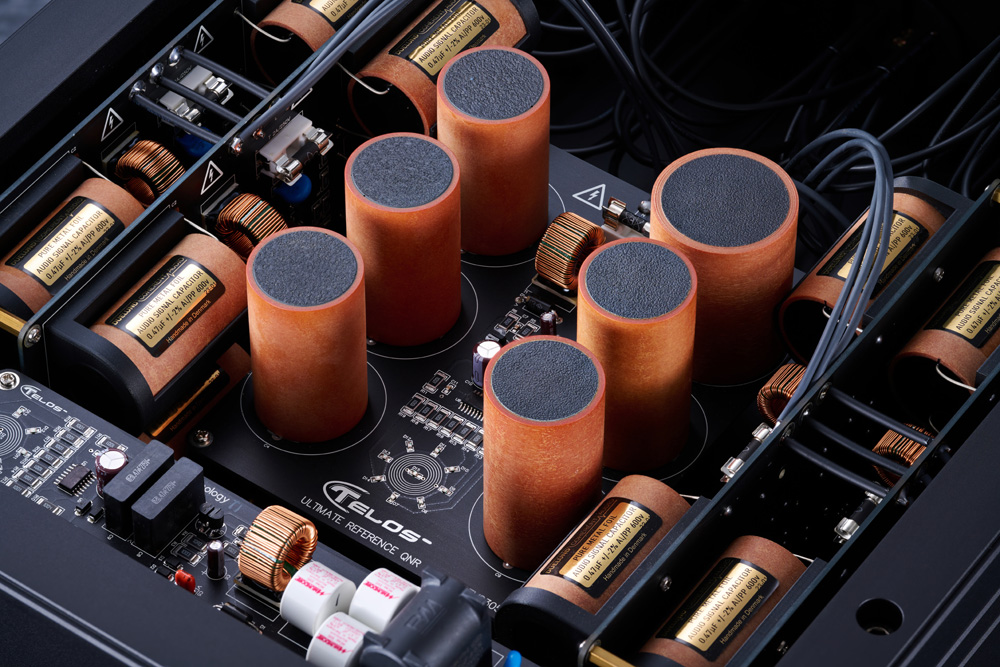
On “Are You In?” from Incubus’ Morning View album, the opening drum fills landed harder than I’d ever heard, with a new physicality. The timbre of the snare, the woody resonance of the toms, even the skin of the kick drum stretched into the room, the decay suddenly had a sense of belonging, like the room breathing out. Mike Einziger’s guitar drifted lazily across the mix, but instead of being a wash, it became a halo. The drum son this track always grab me, but there was now an added level of dimension, a suddenly almost surreal fulfilment.
Hedegaard’s “Vikings (Hey Ho)” was a showstopper. The opening vocal floated like a ghost rising in a cathedral, stretching the room beyond its own boundaries. The listening space seemed to dissolve leaving nothing but an eternity of sound. When the backing vocals entered, the bass expanded, endless, bottomless, expansive and overwhelming. The sheer energy, the drive, the enormous presence of the drums slammed into me. It wasn’t hi-fi anymore; it was myth. The spirits had been summoned, and this was their portal to the living.
As I wrote above, Sheryl Crow’s “I Shall Believe” takes me back to Glasgow, 1995. Sitting in that studio, the Tannoy monitors glowing, smoke curling in the air. Back then, it felt like purity, like intimacy. And yet, hearing it again now, was like a revelation. Backing vocals floated beyond the periphery, the kick drum seemed to find a new depth, but somehow everything had new sense of purpose with no obstructions and yet somehow nothing become more obtrusive than it had been. Frequency separation was more obvious than ever with such subtlety, that the entire composition had a free pass to fill the room and yet found a new sense of authoritative cohesion.
The title track from the Oblivion motion picture soundtrack by M83 (featuring Susanne Sundfør) is, of course, already cinematic, a neon cathedral of synths and Susanne Sundfør’s soaring vocals. The opening pads are weightless layered veils of light, each one distinct. Vocals have a new sense of space, almost like an apparition, luminous and untouchable, floating above the mix with supernatural grace. The Telos combo revealed the architecture of the song, the scaffolding of bass, the carved stone of rhythm, the stained glass of harmonies. This song has a a chorus built on an epic ocean of orchestral euphoria, the entire experience felt like a cathedral collapsing in ecstasy.
On Synthwave Vol.3, The Midnight’s track “Los Angeles” is all about atmosphere, saxophone neon glow, synth-wave nostalgia, the pulse of a city at night. The saxophone somehow gained extra body, reediness, the taste of brass in the air. The bass line throbbed like streetlights flickering down an empty boulevard. The vocals drenched in 80s-style reverb, anchored, solid, human. It felt like standing on a rooftop in the city itself, wind in my face, watching Los Angeles sprawl in electric veins of light. The Telos gear gave the track extra dimensionality, space, a geography of sound. In recent years I have developed a deep affinity for this band, for 80s soaked synth-wave. The absolute treatment of electrical noise suddenly gives all of this neon a sense of high res. Like the 80s became 4k.
On “Woman in Chains” from Tears for Fears’ The Seeds of Love album, the track has always been lush, layered, and powerful. The depth of the bass intro dug deep. Finding new ways to satisfy that need to experience the very deepest of frequencies available to physically affect you. Oleta Adams’ vocal floated with impossible devastating poise, each phrase drenched in emotion but underpinned by absolute clarity. Roland Orzabal’s voice counterpointed like a confessional. The drums, each one finding their place beautifully each strike taut, each decay perfectly timed. The song unfolded like a cinematic landscape: wide, deep, infinite. I have always been impressed with the way this song translates on multiple systems, but I can’t emphasise this enough, introducing the Telos duo into my system creates a new sense of appreciation for the size of the production on this track. There is so much going on that you often get lost in the textured assault on the senses.

Yello’s precision-engineered electronic soundscapes are a revelation in hi-fi. The impeccable attention to detail is always a pleasure to experience. On Yello’s album Toy, the track “Kiss the Cloud” has a complex yet subtle ethereal groove that is seductive, and the rhythmic percussion and embellished nuances give the ears a real experience. Fifi Rong’s vocals seem to float in a perfect cocoon of pure air, devoid of obstruction. The entire affair seems to float in a free space, weightless, purposeful. This wasn’t just reproduction; it was theatre, immersive and irreverent.
Cultural Resonance
Hi-fi has always been haunted by snake oil. Glossy ads full of pseudo-science. Power cords dressed up like jewellery, priced higher than a used car. Products sold on the promise of “blacker blacks” and “more musicality,” as if stringing together vague adjectives is the same as engineering. I’ve seen it, I’ve heard it, I’ve called it out. And too often, I’ve left demos feeling like the only honest reaction would be to puke.
But here’s the thing: just because bullshit exists doesn’t mean the truth doesn’t. Just because most of what’s sold in this space is cosmetic doesn’t mean the fundamentals don’t matter. The problem is, when you get burned enough times, you stop believing anyone who says they’ve solved it. That’s why Telos feels different.
Jeff Lin doesn’t talk like a snake-oil salesman. He talks like an engineer who’s been obsessed with electricity for decades, not just in audio, but in industries where lives, money, and stability actually depend on getting it right. He doesn’t sell mysticism. He shows you numbers. He demonstrates. And then he lets the music prove itself. That’s punk. Punk isn’t about selling fantasy. Punk is about stripping things down to the studs and saying: here it is, raw and unfiltered. You like it or you don’t. But it’s real.
The cultural weight of what Telos is doing lies in that honesty. We live in an era of curated illusion, where every brand tries to wrap itself in mythology. But mythology without truth is just marketing. What Jeff has built is something that slices straight through the haze, not just electrically, but metaphorically. It’s hi-fi without the lies.
And it matters. Because music isn’t a hobby for some of us. It isn’t wallpaper. It’s religion, rebellion, catharsis. I’ve spent my life in studios, chasing clarity, trying to carve frequency space so every note has its place. I’ve seen artists fight for the perfect take, the one where the hair stands on the back of your neck. I’ve watched entire mixes fall apart because of fatigue, noise, bad acoustics, the fundamentals gone wrong.
So when I tell you that the Telos Monster Series Power Station and Earth Grounding components rebuilt the stage under my system, I don’t mean it politely. I mean it viscerally. This is the difference between watching a band through a dirty window and standing in the front row, sweat dripping, every note drilling into your chest.
In a hi-fi culture that often confuses status with substance, Telos Audio Design feels like rebellion. They don’t make products for Instagram. They make products that clear the bullshit out of the way so the only thing left is music.
And that’s why this isn’t just an upgrade. It’s a cultural moment. It’s a reminder that the fight for fidelity and truth is still alive. It’s punk in its refusal to dress up as anything other than what it is: a ground system, a power system, engineered with ruthless precision, that changes everything.
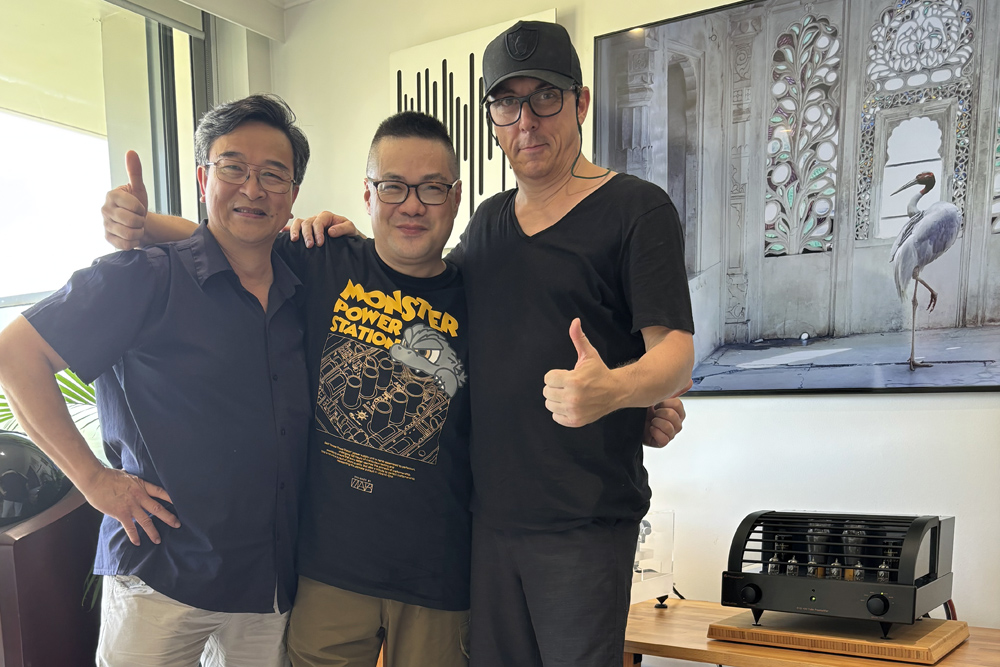 Telos Audio Design’s Peter Woo & Jeff Lin with reviewer Barry J Johnston
Telos Audio Design’s Peter Woo & Jeff Lin with reviewer Barry J Johnston
Conclusion
My heart sank a little knowing I couldn’t go back to life without this. Let’s be straight, my system was great before. Not good. Great. I’d built it, tuned it, lived with it. I was proud of it. But this? This was something else entirely. I challenge anyone to experience what Telos Audio Design does and not share my opinion. What it removed from the signal added so much more space, more life, more relatable immersion.
After 30 years of mixing, producing, building studios, mixing live shows, I thought I’d seen most of what could be done. But this was a revelation. A brand new level I didn’t think existed. And that’s the kicker. Once you hear it, you can’t un-hear it. You don’t go back.
I have literally started enjoying music more again. I haven’t lost the love of the gear, but I have definitely become more in tune with music again. I’m not thinking about more gear as much as I’m discovering new music, enjoying what I have. Look deeper, if you want to truly improve performance, I absolutely assure you this is it.
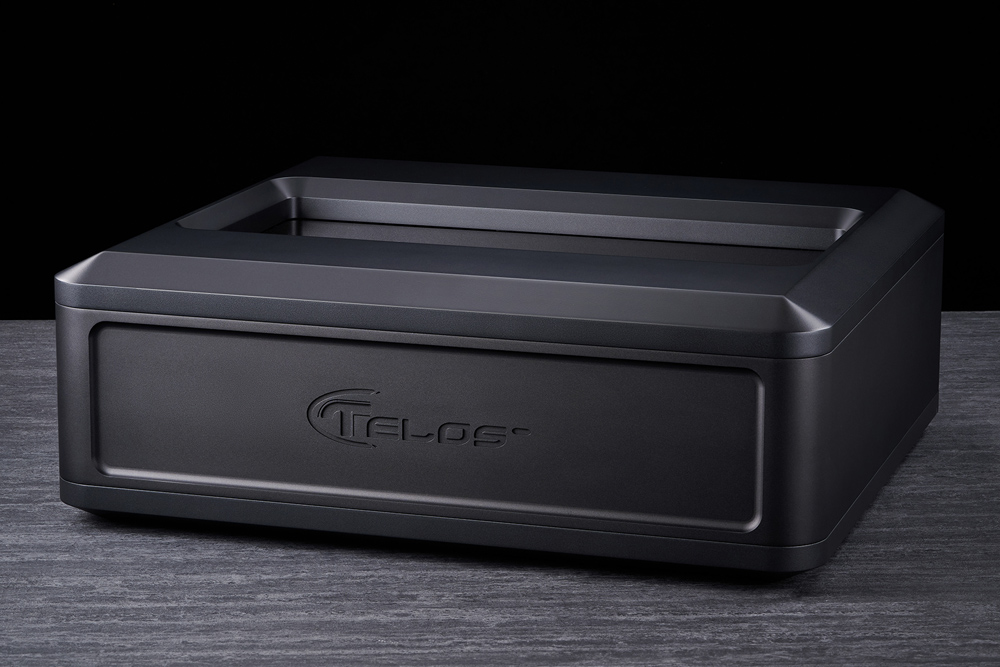
I know Jeff is working on a more affordable line, and thank God for that, because these units aren’t cheap. They weigh a tonne, and I swear sometimes I think Telos charges by the kilo. But let’s cut through it: I’m convinced this is the single most significant, most worthwhile upgrade you can make to a system. Why? Because every single component benefits from the same fundamental core improvement. Power. Ground. Stability. Strip out the noise and suddenly the whole rig locks in.
Here’s the kicker: you stop thinking about changing anything else. Instead, you start thinking about music again. You dig out old records. You go hunting for new bands. You remember why you started down this road in the first place. It’s not about kit anymore. It’s about discovery.
So, here’s my humble opinion, for what it’s worth: if you’ve got the readies and can truly afford it, the Telos Audio Design Monster series Power Station and Earth Grounding units will elevate your system in a way you will not believe until you try it. And if your system is already “no-budget, no-compromise”? Then you don’t just need these… You’re incomplete without them.
… Barry James Johnston
www.soundstageaustralia.com
Associated Equipment
- Speakers — Bowers and Wilkins Nautilus 802, Yamaha NS1000 – 2 Pairs – Modified, KEF LSX, REL HT1205 x 2, JBL 4328 LSR, Sony subwoofer, 2 x REL Acoustics No.31 subwoofers
- Amplifier — Mark Levinson No.531H Monoblocks, Quad 606 Power amp, Sansui AU555 Integrated
- Preamplifier — PrimaLuna EVO 400
- Sources — Digital: Gryphon Scorpio, Metronome Technologie Le Player 4+, Simaudio Moon HAD230, Marantz PMD-340, (MacBook Pro 15 - Audirvana, Tidal, Spotify) Sony PHA3, Sony NW ZX2, Sony PCM2600
- Analogue: Marantz TT-15S1, Clearaudio Satisfy Tonearm, Clearaudio Virtuoso Wood MKII, Whest P.20, LINN LP12, Stax UA7CF Tonearm, Audio Technica LPW40WN
- Cables — Nordost Frey, inakustik Exzellenz Balanced interconnect, Isotek IEC, various custom interconnects
- Audio Rack — Custom – Noizy Head, Noizy Head custom iso platforms
- Miscellaneous — Audio Technica AT-AWAS, Focal Listen, Audio Technica MSR7, Mac Pro, Focusrite Scarlett 18i20, Vicoustic room treatment, and various supporting cast
Telos Audio Design Monster Series Power Station Standard Edition & Earth Grounding Standard Edition
Price: Power Station US$50,000, Earth Grounding US$40,000
Global Warranty: Two Years
Australian Dealer Finder Not Available (Telos Direct)
Australian Distributor: Telos Audio Design Direct
Sheng-Kai Co., Ltd
No.102, Pingding Road,
Tamsui Dist., New Taipei City 251
Taiwan (R.O.C.)
+886 2 8626 0773
https://telos-audio.com.tw/
